Table of contents
- No-name tires 120/70 ZR 17, 180/55 ZR 17 in the test They can only be cheap?
- Shinko and Maxxis technically old
- High tech at Nankang and Mitas
- Country roads, autobahns and the wet
- No-name tires in the wet
- Full Bore USA M-1 Street Sport
- valuation
- Conclusion
- Maxxis Supermaxx Radial
- valuation
- Conclusion
- Mitas Sport Force
- valuation
- Conclusion
- Nankang Roadiac WF-1
- valuation
- Conclusion
- Shinko F009RR / R009RR
- valuation
- Conclusion
- This is how MOTORRAD tests
- Final evaluation and conclusion
- Pre-release version of the Nankang Sportiac WF-2
- Premium at a discount rate
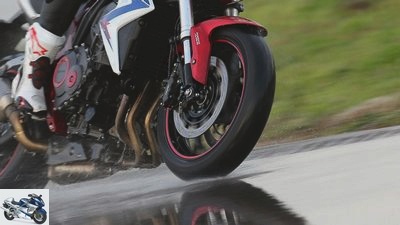
Jahn

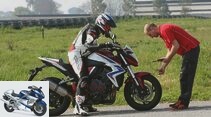
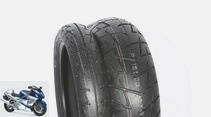
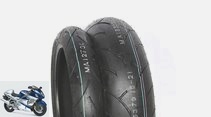
20th pictures
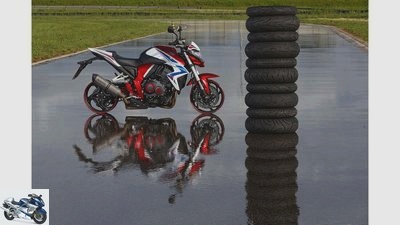
Jahn
1/20
No-name, exotic or cheap brands: Regardless of which label you want to overwrite the third part of our tire test with – this story is primarily about big money.
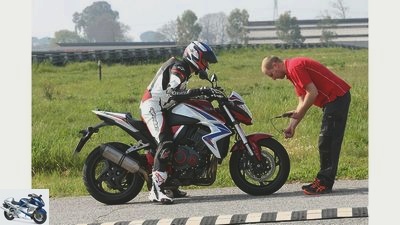
Jahn
2/20
Yes, where do you heat? Temperature check for always the same conditions.
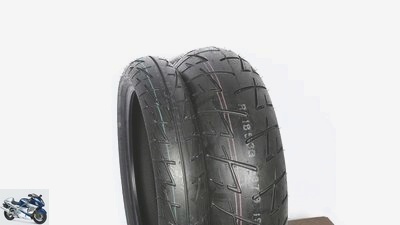
mps photo studio
3/20
The 5th. Place is occupied by the Shinko F009RR / R009RR. The lap definitely doesn’t want to get around corners: Curvy stretches are as little fun with the stubborn Shinko as the sometimes slippery tour over wet asphalt.
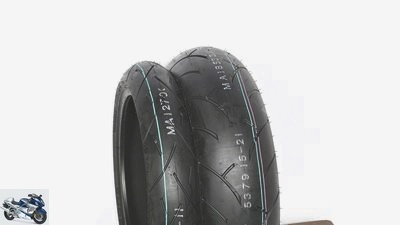
mps photo studio
4/20
4th place went to the Full Bore USA M-1 Street Sport. Even under ideal conditions, the Full Bore’s performance remains poor with its sluggish nature, little feedback and a clear tendency to shimmy. When it rains, your heart immediately sinks into your pants.
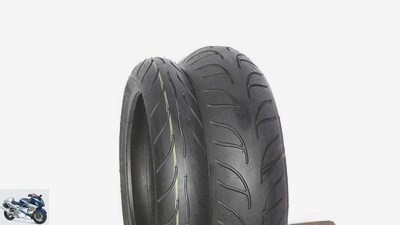
mps photo studio
5/20
Third place went to the Nankang Roadiac WF-1. With its bicompound construction, Nankang relies on modern tire technology, but in practice there are no real advantages to be found on dry or wet roads.
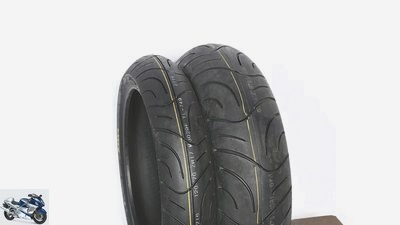
mps photo studio
6/20
The Maxxis Supermaxx Radial came in second. At the end of the day, the Supermaxx reaps only one “conditionally recommendable” despite being second: If the road is dry, it is still acceptable. But much more is possible in the wet.

mps photo studio
7/20
The winner is the Mitas Sport Force. Handy, sporty, inexpensive: the Mitas Sport Force drives significantly different from the competition in the test. And even when it rains, he doesn’t bend his knees prematurely. A good set for around 150 euros.
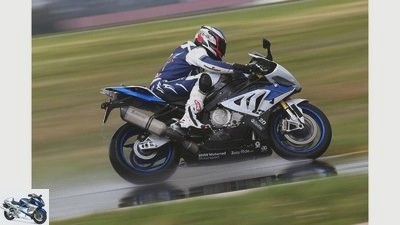
Jahn
8/20
The first Roadiac is far from over for Nankang. They also want to get involved in the future with the high-horsepower super athletes.

mps photo studio
9/20
Nankang Sportiac WF-2: coming soon as a 190.

Jahn
10/20
Also against the very Middle East: Four Asia-rubbers compete against one from Eastern Europe.
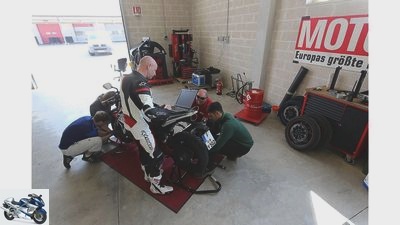
Jahn
11/20
Just a short pit stop: read out the data, move the wheelsets, and get back on the slopes.
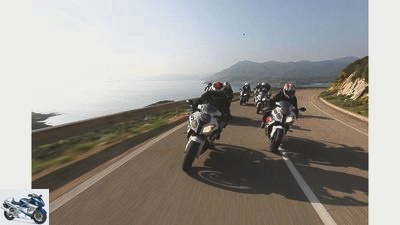
Jahn
12/20
Six sports tires have already been tested in race mode, in the wet and in everyday long-distance tests.
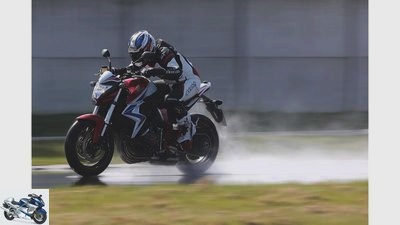
Jahn
13/20
There are also seven touring tires in the universal dimensions 120/70 ZR 17 and 180/55 ZR 17.

Lohse
14/20
Super grid girls, but also super grip? This time there are five no-name tires in the everyday test.
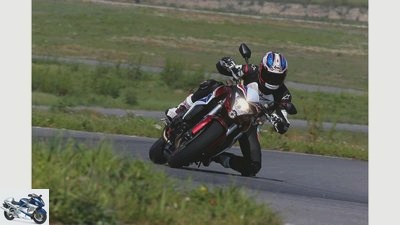
Jahn
15/20
Basically, this chapter clearly shows the huge leaps in development that modern motorcycle tires have made in the last two decades.
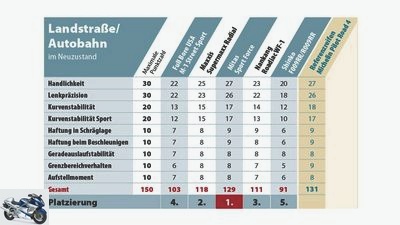
BILLION
16/20
In order to be able to understand this, we have also shown the values of the touring tire test winner.
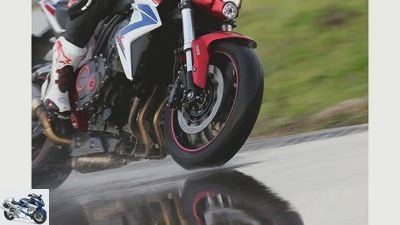
Jahn
17/20
In terms of weighting, the wet test chapter is subordinate to the everyday country road test – which has a lot to do with reality: Motorcycles are simply used more often in ideal (dry) conditions.
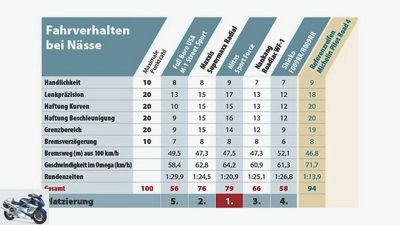
BILLION
18/20
Here is the evaluation of the tires in the wet. Also included: the Michelin Pilot Road 4.
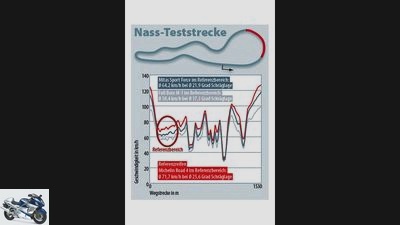
BILLION
19/20
A curve that says it all: our Michelin reference tire shows what is actually possible on a wet road. The Mitas has to admit defeat, but its performance is at an acceptable level. With the full bore, the
Trip to a dangerous slide.
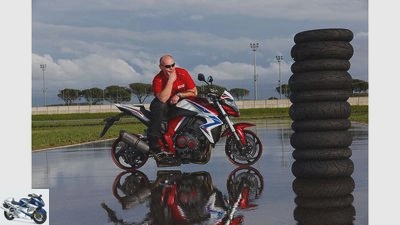
Jahn
20/20
Risk: If you buy tires too cheaply, you run the risk of expensive follow-up costs.
accesories
tire
Inexpensive motorcycle tires in the product test
No-name tires 120/70 ZR 17, 180/55 ZR 17 in the test
They can only be cheap?
They are called Nankang, Shinko or Mitas. You come from Taiwan, South Korea or Slovenia. And they want to be in the business of prestigious 180 radial tires for big bikes. No-name rubbers, so the regulars’ slogan, can only be cheap. Our test clarifies: Do the five exotic species really … don’t care?
Jorg Lohse, Karsten Schwers
05/22/2014
No-name, exotic or cheap brands: Regardless of which label you want to overwrite the third part of our tire test with – this story is primarily about big money. And a little more about globalization, growth, new markets, displacement … But first let’s take a look at the market for motorcycle tires in Germany. Here, the so-called replacement business (which goes to the rims after the initial tires) has been neatly divided between the six well-known premium brands.
Buy complete article
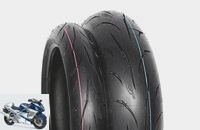
Best purchase no-name tires 120/70 ZR 17 and 180/55 ZR 17 (MOTORRAD 12/2014)
Mitas Sport Force
8 pages) as PDF
€ 2.00
Buy now
According to surveys by the industry magazine “Neue Reifenenzeitung” (www.reifenpresse.de) Almost 70 percent of the market is divided almost equally between Bridgestone, Metzeler and Michelin. The remaining 30 percent are determined by Conti, Dunlop and Pirelli. Other manufacturers are almost irrelevant. According to the figures of the Federal Association of Tire Trade and Vulcanization Crafts, the big six sell around 1.3 million motorcycle tires per year. In the past ten years, two segments in particular have achieved significant gains. With 350,000 tires per year, the sports and touring (sports) tires in radial construction are particularly in demand. Cross-ply tires for touring sports are well behind in third place with almost 200,000 tires per year.

tire
6 pairs of touring tires in the test
Touring tires on Suzuki GSX-S 750
read more
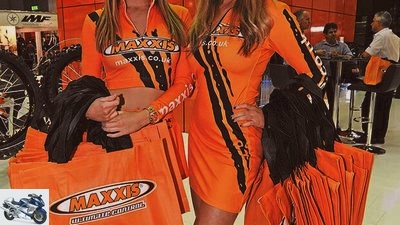
Lohse
Super grid girls, but also super grip? This time there are five no-name tires in the everyday test.
The music plays with an estimated 60 to 80 million euros in sales per year for radial touring and sports tires. If you want to get involved, you also have to offer these in the sizes that are in demand: the dimensions 120/70 ZR 17 and 180/55 ZR 17 come to over 30 percent according to Europool, an institution that records manufacturers’ sales to tire dealers . And now the manufacturers want to cut a juicy piece of this cake from this test. But who is exactly behind it?
This information is sometimes difficult to obtain, even for industry insiders. For example, the answer to the question of who or what is behind the Full Bore USA brand. In Germany, the label is sold through Delticom, one of the largest internet tire dealers based in Hanover (www.motorradreifendirekt.de). Upon request, it can be learned that the brand belongs to the tire distributor “Motoman” from the USA. In 2008 a sport radial tire (the M-1 from our test) for the US market was presented there, later rubbers for choppers, cruisers and tourers followed. But who is responsible for development and production? At Delticom it is nebulous that the tires are co-developed by Japanese engineers. On the side wall of our test tires, however, there is a reference to the production in South Korea. A renewed inquiry makes it clear what was already suspected: The full bore tires come from Shinko, another test participant, and are essentially based on the know-how of the South Korean tire manufacturer. But who is Shinko?
Shinko and Maxxis technically old
One of them caught a particularly old fish on our shopping tour. The profile “F / R009RR” has a current production date of 2013, but in its basic form the radial tire is around 20 years old, as the German salesman Alfred Schenk (www.shinkoreifen.de) confirmed. This explains the Japanese know-how, which is also referred to at Shinko. In 1994 Shinko took over the production of the Japanese Yokohama motorcycle tires, including the technology and tools. So many Shinkos originally had Yokohama on the side wall. Shinko themselves, who started producing bicycle tires in Japan in 1946, are now part of the South Korean Shin Hung Group, which has been producing motorcycle tires since 1979. In the industry, Shinko has built a reputation for making cross-ply tires. Which is why they also take on contract work from premium brands: Some of the legendary Conti TKC 80 tires come from the Shinko factories in South Korea.
The situation with the two other Asian tires from this test is completely different. Behind Maxxis CST, the abbreviation for “Cheng Shin Taiwan”, has been in business since 1967. Maxxis is first and foremost the name that promises more pulling power for the European and US business. Among the global players, CST / Maxxis is not insignificant. In 2012 the group reached ninth place in the ranking of the largest companies in the tire industry, according to information from the “Neue Reifenenzeitung” with sales of 3.4 billion euros. Most of the money, however, is made with car and trailer tires, motorcycle tires only make a fraction. The test tire also proves that this is less important: the Supermaxx is technically over ten years old!
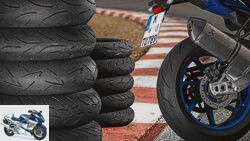
tire
PS sports tire test 2014
Six sports tires in comparison
read more
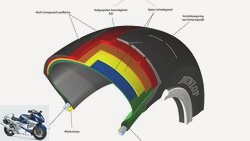
tire
PS knowledge tire lexicon
The ABC of tires
read more
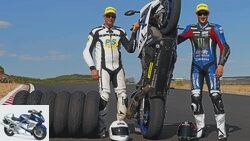
tire
Endurance test of Dunlop sports tires
Road tires, slicks, IDM qualifying rubber
read more
High tech at Nankang and Mitas
The second Taiwan rubber from the manufacturer Nankang, based in Taipei, is completely different: Its Roadiac was only introduced in 2010 and is their first real motorcycle tire. Mainly around 13 million car tires are produced annually at Nankang with around 2,700 employees. With the two-component mixture, the Roadiac and its new sister model Sportiac are definitely using high-tech in order to make a name for themselves with bikers in the future.
That has Mitas already. The speedway scene in particular has known the brand for decades. It belongs to the Czech ČSG Group, which makes a large part of its turnover (2011: 430 million euros) with tractor tires. In 2012, the Slovenian manufacturer Savatech was taken over and the development of radial tires started there is now continuing under the Mitas flag. With initial success, as this test shows.
Country roads, autobahns and the wet
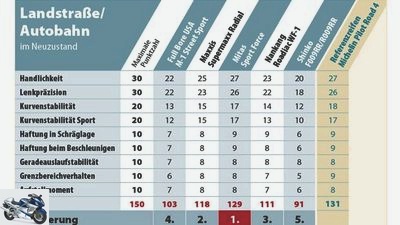
BILLION
The evaluation of the no-name tires on country roads and motorways
Basically, this chapter clearly shows the huge leaps in development that modern motorcycle tires have made in the last two decades. In order to be able to understand this, we have also shown the values of the touring tire test winner (issue 11). It is therefore relatively easy to build a radial tire for high-horsepower motorcycles that simply runs in a straight line. But who always wants to stubbornly bolt ahead with their bike? At the moment when more dynamism is demanded from the tire at the same time, the difficulties begin. Maintain stability, but at the same time increase agility: How do you implement it without the tire becoming wobbly or nervous? No chance for the conceptually oldest tire in the test: The Shinko is, although our test tires from the trade were produced in the course of last year, clearly a child of the 90s – it is based on old Yokohama skins that have been around for almost 20 years are no longer offered! Moderate handiness, poor steering precision, weaknesses in corners and on top of that little grip reserves. It can be seen most clearly that modern tire technology has now arrived in completely different regions. On top of that, this set is not even cheap to get. With a pair price of around 220 euros, the Shinko ranks on the level of the premium brands.
Conclusion
In order to build radial tires that work with modern bikes on winding country roads and at high speed on the train, it is not enough to infuse old concepts. Shinko and Full Bore no longer make a cut, Maxxis is still acceptable. Nankang dares to use a contemporary bicompound rubber compound, but has still to learn a lot. On the other hand, close to the premium class: the new tires from Mitas.
No-name tires in the wet
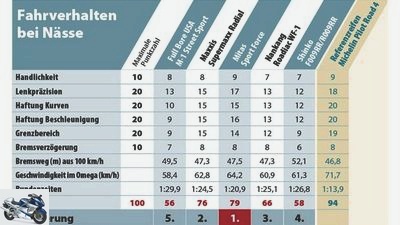
BILLION
Here is the evaluation of the tires in the wet.
In terms of weighting, the wet test chapter is subordinate to the everyday country road test – which has a lot to do with reality: Motorcycles are simply used more often in ideal (dry) conditions. For many motorcyclists, however, wet performance is a decisive, if not the decisive, purchase criterion. After all, you want the tire to offer the highest possible safety cushion in adverse conditions: a lot of grip in corners, clear feedback for the grip reserves, short distances in the event of emergency braking. Accordingly, many premium suppliers have pushed the development in this sector far forward over the past ten years. An important component is, for example, the use of silica, a silicic acid compound that makes the rubber nice and supple even at low tire temperatures. However, the adjusting screws must be turned carefully so that the tire does not overheat and smear away dangerously on warm, sunny days – or show noticeably heavy wear. In part two of our tire test series, Michelins Pilot Road 4 showed an almost ideal mix.
Conclusion
In a direct comparison of the five test candidates, the conceptually quite young Mitas Sport Force also shows the best performance. However, at least 15 points separate him from the touring tire test winner from part two of our tire test. So there is still plenty of potential for expansion. Shinko and Full Bore, on the other hand, are no longer up to date, even in the rain.
Full Bore USA M-1 Street Sport
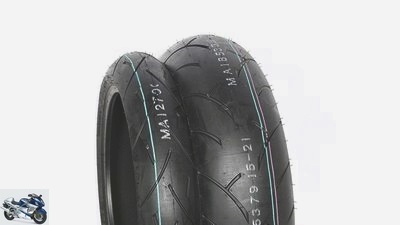
mps photo studio
The Full Bore USA M-1 Street Sport.
Weight: 4.3 kg at the front, 6.7 kg at the rear
Country of Manufacture: South Korea
Info / approvals: Delticom, Tel. 0 18 05/26 22 68, www.delti.com
Purchase price: 58.60 / 82.40 euros (front / rear) www.motorradreifendirekt.de
valuation
Country road / motorway: (103 points, 4th place)
Even if the full bore is not one of the handy tires, it drives noticeably better than the Shinko from the same production facility. In addition, there is better feedback, so that, compared to the Shinko, there is more of a feeling for the adhesion potential in curves. But compared to well-known premium tires, there is a lack of feedback and agility. A pronounced shimmy is particularly annoying – both when driving straight ahead and in an inclined position. Attention: With their W-marking without brackets, the Full Bore as well as the Shinko are only permitted up to 270 km / h.
Wet test: (56 points, 5th place)
The Full Bore offers better feedback and is more manageable than the Shinko, but it slips much earlier when accelerating and when tilting. Which is why in no situation trust the actual imprisonment-
like to set reserves. This is also reflected in the measured values with the slowest lap time and the lowest cornering speed. Only when braking from 100 km / h does it stand a little faster than the Shinko.
Conclusion
Even under ideal conditions, the Full Bore’s performance remains poor with its sluggish nature, little feedback and a clear tendency to shimmy. When it rains, your heart immediately sinks into your pants.
MOTORRAD verdict: 4th place, with 159 points
Maxxis Supermaxx Radial

mps photo studio
The Supermaxx Radial.
Weight: 4.3 kg at the front, 6.7 kg at the rear
Country of Manufacture: Taiwan
Info / approvals: Maxxis International, Tel. 0 48 21/8 90 60, www.maxxis.de
Purchase price: 76.60 / 97.70 euros (front / rear) www.motorradreifendirekt.de
valuation
Country road / motorway: (118 points, 2nd place)
The Maxxis initially pleases with its comparatively easy turning behavior, which is why it is much more manageable than the competitors from Shinko and Full Bore. However, there is a lack of neutrality: the Supermaxx quickly feels wobbly at high inclines. Overall, the Taiwan tire, unlike the Koreans, gives better feedback for its adhesive reserves, which is why the CB 1000 R can be steered through corners at considerable lean angles. However, it lacks the necessary cornering stability at a brisk pace. The righting moment when braking in an inclined position is noticeable, but is significantly lower than with Shinko or Full Bore.
Wet test: (76 points, 2nd place)
Even in the rain, the Maxxis with its wider limit area and advantages
Set it apart from competitors Shinko, Full Bore and Nankang in terms of handiness and feedback. Nevertheless, there is a clear gap to the best in the test (Mitas Sport Force), which can also be seen from the measured values:
minus 10 km / h when accelerating out of corners!
Conclusion
At the end of the day, the Supermaxx reaps only one “conditionally recommendable” despite being second: If the road is dry, it is still acceptable. But much more is possible in the wet.
MOTORRAD verdict: 2nd place with 194 points
Mitas Sport Force
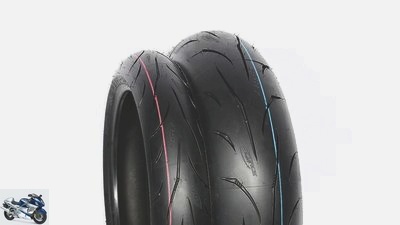
mps photo studio
The Mitas Sport Force.
Weight: 4.8 kg at the front, 6.7 kg at the rear
Country of Manufacture: Slovenia
Info / approvals: Mitas, Tel. 05 11/93 61 76 60, www.mitas-tyres.com
Purchase price: 69.70 / 83.90 euros (front / rear) www.motorradreifendirekt.de
valuation
Country road / motorway: (129 points, 1st place)
On the country road, the Mitas Sport Force impresses with its amazingly good driving characteristics, as it can be turned in a sporty and light-footed manner and remains very neutral even on high lean angles. In addition, he gives extremely good feedback on his detention reserves in the first few meters. These are more than sufficient to be able to bend extremely diagonally around the corner. With the very good steering precision, the Mitas can be kept on course with ease. In these points it is already at the level of well-known premium brands and can even compete with the best from the touring tire test (Conti Road Attack 2 Evo, Michelin Pilot Road 4).
Wet test: (79 points, 1st place)
Even on wet roads, the Slovenian tire has a clear lead over the other tires in the test. His measured values are even on the level of good touring tires from part two (issue 11/2014). Its advantages: wide limit range, good feedback for the grip reserves, convincing braking values.
Conclusion
Handy, sporty, inexpensive: the Mitas Sport Force drives significantly different from the competition in the test. And even when it rains, he doesn’t bend his knees prematurely. A good set for around 150 euros.
MOTORRAD verdict: 1st place with 208 points
Nankang Roadiac WF-1
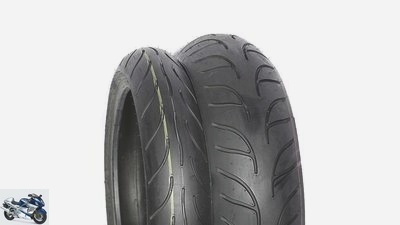
mps photo studio
The Nankang Roadiac WF-1.
Weight: 4.9 kg at the front, 6.9 kg at the rear
Country of Manufacture: Taiwan
Info / approvals: Delticom, Tel. 0 18 05/26 22 68, www.delti.com
Purchase price: 53.00 / 75.70 euros (front / rear) at www.motorradreifendirekt.de
valuation
Country road / motorway: (111 points, 3rd place)
The only pair of tires in this test is the particularly inexpensive Roadiac (pair price: 128.70 euros!) Front and rear with two different rubber compounds (“bicompound”), which should ensure less abrasion (tire center) and more grip (tire shoulder) . But the set-up is not convincing: Overall, the Roadiac steers a little too heavily into corners, and slight counter-steering forces are required to keep the motorcycle on course. When braking in an inclined position, a clear pitching impulse interferes. The only moderate feedback does not give a sure feeling for the grip reserves in curves, and the mixed steering precision thwarted the clean line in curves.
Wet test: (66 points, 3rd place)
The moderate handiness and the low adhesive reserves take their toll, especially on wet asphalt: Even in a cautiously sloping position, wide curves have to be driven in order not to slip. Overall, the border area is far too narrow. The Roadiac only achieves acceptable values when going straight ahead and when braking.
Conclusion
With its bicompound construction, Nankang relies on modern tire technology, but in practice there are no real advantages to be found on dry or wet roads.
MOTORRAD verdict: 3rd place with 177 points
Shinko F009RR / R009RR
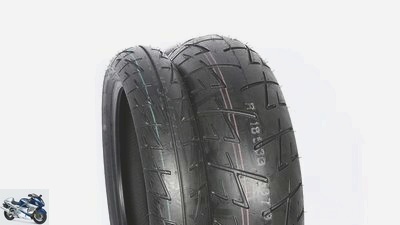
mps photo studio
The Shinko F009RR / R009RR.
Weight: 4.7 kg at the front, 7.0 kg at the rear
Country of Manufacture: South Korea
Info / approvals: MC tire service, Tel. 0 97 21/50 94 63, www.shinkoreifen.de
Purchase price: 84.70 / 135.90 euros (front / rear) www.motorradreifendirekt.de
valuation
Country road / motorway: (91 points, 5th place)
The conceptually probably oldest tire in the test (based on Yokohama tires from the 90s) is particularly stubborn on the country road. Significant counter-steering forces are required from a slight lean angle to keep the Honda on course from our test. The low internal attenuation is also disturbing, which means that the feedback is too dry. When starting the new tires, there is initially no pleasant feeling for the maximum possible cornering grip. It is therefore very hesitant to approach higher degrees of inclination. Despite correct balancing, a clear shimmy was already disturbing straight-ahead and cornering when it was new. Just as annoying: the strong setup-
impulse when braking in an inclined position.
Wet test: (58 points, 4th place)
If you only drive straight ahead, you could still live with the grip of the Shinko. But alas, there is a curve! Not only are the reserves used up quickly, the inadequate feedback also means that there is no sure feeling for the limit. The braking values are not convincing either.
Conclusion
The lap definitely doesn’t want to get around corners: Curvy stretches are as little fun with the stubborn Shinko as the sometimes slippery tour over wet asphalt.
MOTORRAD verdict: 5th place with 149 points
This is how MOTORRAD tests
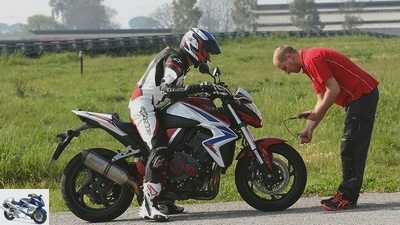
Jahn
Yes, where do you heat? Temperature check for always the same conditions.
As in part two of the tire test (booklet 11), the base motorcycle for the test of these no-name radial tires was a Honda CB 1000 R. All tires from this test were ordered in February 2014 at the prices stated above via the Delticom online shop.
Handiness
Steering effort required to tilt the machine or to keep it in line in slow / fast alternating curves.
Cornering stability / pillion
Stability in (changing) curves and on bumps. Is tested in different modes (solo / with pillion passenger) at a great lean angle when accelerating, whereby the tires can really rock up.
Steering precision
Test in passages of different speeds with complicated curve radii. Provides information about whether the motorcycle is following the desired course, which is specified by the steering forces, or whether clear line corrections are required.
Straight-line stability
High speed on the highway. Does the motorcycle stay stable on course or does the commuting interfere with the journey??
Liability in an inclined position
Side guidance in maximum inclination on wet and dry asphalt. A tightrope walk that is only possible on a closed route.
Erection moment
When braking in an inclined position, the motorcycle straightens up differently depending on the deceleration and tire contour. This reaction must be balanced out with a counterforce on the inside of the handlebar end.
Adhesion when accelerating
Lateral guidance and power transmission in corners at different speeds. Is also tested in wet and dry conditions.
Borderline behavior
Controllability of the tire at the limit of grip. The test is carried out on both wet and dry tracks.
Filling pressure in the test
2.5 bar at the front, 2.9 bar at the rear.
Final evaluation and conclusion
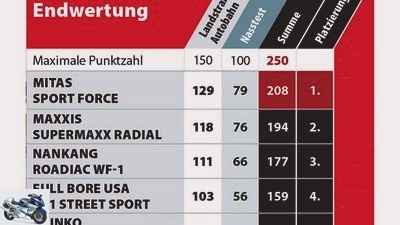
BILLION
The final score of the tire test.
Almost 60 points separate the first and last. This shows that the field of so-called no-name radial tires cannot be judged across the board. Mitas proves with the young Sport Force that you can certainly reach the quality of the well-known profiles from Bridgestone to Pirelli. Full Bore and Shinko, on the other hand, conserve tire technology from the 1990s.
Pre-release version of the Nankang Sportiac WF-2
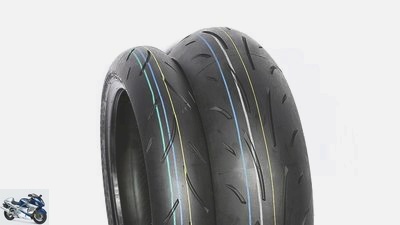
mps photo studio
Nankang Sportiac WF-2: coming soon as a 190.
The first Roadiac is far from over for Nankang. They also want to get involved in the future with the high-horsepower super athletes. As part of our tests, we had a preliminary version of the Sportiac WF-2 in the dimensions 120/70 and 190/55 ZR 17, which we were able to test on the BMW HP4 analogous to the sports tires in part one (booklet 10). Unlike the tourist sister model Roadiac, the Sportiac, which is also constructed as a bicompound tire, turns in more easily and is much more neutral. The feeling for the custody reserves also comes in a little faster now. In wet conditions, he can also move away from the Roadiac, but the limit area that sets in early sets a limit all too quickly. But before the Sportiac goes on sale, Nankang has announced further revisions.
Premium at a discount rate
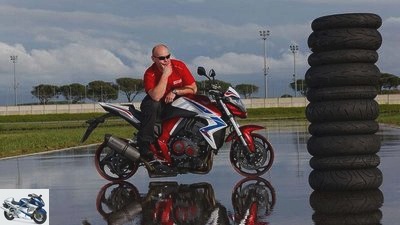
Jahn
Risk: If you buy tires too cheaply, you run the risk of expensive follow-up costs.
Saving money when buying tires is not easy. Since the manufacturers do not give a “recommended retail price”, every retailer – in a real store or online shop – calculates differently. If you don’t want to do without premium brands when saving, you should consider the so-called “secondline” of the manufacturer.
Bridgestone
The predecessor of the current T 30 touring tire is the BT 021 for the Japanese tire brand. In the MOTORRAD tests, it impressed above all with its manageable design paired with good cornering stability. However, its rather mixed quality in wet conditions is less appealing.
Price example: Bridgestone BT 021 in 120/70 ZR 17 and 180/55 ZR 17 for 171.98 euros www.mopedreifen.de
Continental
The brand new Road Attack 2 Evo was awarded the country road tip in the last issue. And the original version of the Road Attack also proved to be handy, precise and blessed with a lot of grip in our tests. Its drawback: the noticeably high level of wear.
Price example: Conti Road Attack in 120/70 ZR 17 and 180/55 ZR 17 for 181.50 euros www.reifendiscount.de
Dunlop
Five years ago, the Roadsmart heralded the new era of touring tires at Dunlop. With success: In 2009, the Roadsmart won the MOTORRAD tire test together with the Michelin Pilot Road 2, primarily due to its good grip, its neutrality and clear feedback in the rain.
Price example: Dunlop Roadsmart in 120/70 ZR 17 and 180/55 ZR 17 for 198.40 euros www.reifentiefpreis.de
Michelin
Anyone looking for something special for safe driving in adverse conditions has not been able to get hold of the French rubber for years
past. The Pilot Road 4 is currently convincing, but the number two was already able to shine with sensational driving performance in the rain. His shortcoming? A little too wobbly.
Price example: Michelin Pilot Road 2 in 120/70 ZR 17 and 180/55 ZR 17 for 192.55 euros www.gibgummi24.de
Pirelli
The sporty tire brand from Italy has also made a good name for itself among motorcycle tourists. In the last tests, the Angel ST and GT were convincing, and before that the Diablo Strada was already a benchmark thanks to its balanced character with immaculate passenger qualities.
Price example: Pirelli Diablo Strada in 120/70 ZR 17 and 180/55 ZR 17 for 164.98 euros www.tirendo.de
Related articles
-
Motorcycle touring tires 120-70 ZR 17 and 180-55 ZR 17 in the test
Jahn 30th pictures Jahn 1/30 mps photo studio 2/30 Metzeler Roadtec Z8 Interact: MOTORRAD verdict: 6th place, 212 points. mps photo studio 3/30 Michelin…
-
Enduro tires 120-70 R 19 and 170-60 R 17 in the product test
markus-jahn.com 34 pictures markus-jahn.com 1/34 On the way tip: on towel-wide single tracks through rustic forests, in between winding Carrera tracks,…
-
Sports tires in the 2013 tire test
Jahn 23 pictures Jahn 1/23 The 2013 MOTORRAD sports tire test. Jahn 2/23 The sports tires on the country road and motorway. Jahn 3/23 Where did the…
-
Six sports tires in the sporty country road and wetness test
Markus Jahn, mps photo studio 15th pictures Markus Jahn, mps photo studio 1/15 In the fourth part of our tire test, six current sports tires have to face…
-
Tire test 2013: touring tires 120-70 ZR 17, 180-55 ZR 17
Jahn 20th pictures Jahn 1/20 Tire test 2013: 6 touring tires of the dimensions 120/70 ZR 17, 180/55 ZR 17. Jahn 2/20 The same conditions for everyone:…
-
Motorcycle tires for classic and youngtimers in the test dimensions 100-90-18 and 120-90-18
markus-jahn.com 22nd pictures markus-jahn.com 1/22 The tire test for classics and youngtimers was made with a 1991 Yamaha XJ 900 F.. markus-jahn.com 2/22…
-
Road tires 2019 for large travel enduros in the test
Markus Jahn 17th pictures Markus Jahn 1/17 Which tire pairing has the edge after the tour over streets of all stripes?? Markus Jahn 2/17 If you value…
-
MOTORRAD tire test 2016 – touring tires
markus-jahn.com 14th pictures markus-jahn.com 1/14 Picture gallery: Touring tires 120/70 ZR 17 and 180/55 ZR 17 in the test. markus-jahn.com 2/14 After…
-
Sports tires 120-70 ZR 17 and 190-55 ZR 17 in a comparison test
markus-jahn.com 18th pictures markus-jahn.com 1/18 Motorbike sports tires in the dimensions 120/70 ZR 17 and 190/55 ZR 17 in the test. markus-jahn.com…
-
Test winner tire test part 2 – Enduro tires (MOTORRAD 13-2015)
mps studio accesories tire Test winner tire test part 2 – Enduro tires (MOTORRAD 13/2015) Test winner tire test part 2 – Enduro tires (MOTORRAD 13/2015)…